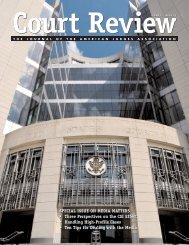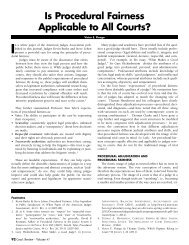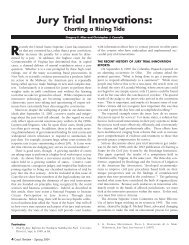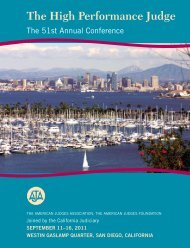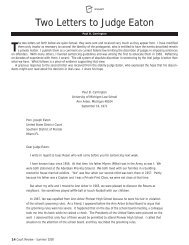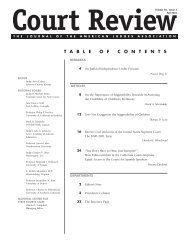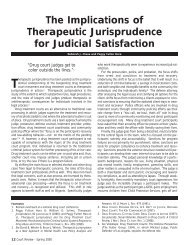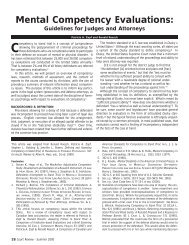judges, if procedural fairness is entered into the equati<strong>on</strong>, thenfactors such as race, ethnicity, and gender become statisticallyinsignificant. People share a comm<strong>on</strong> basis for deciding <strong>on</strong>what is fair. If minority group members report less trust andc<strong>on</strong>fidence in the courts than do whites, it is because theybelieve the procedures court follow are not fair.Designing new court forums<strong>Procedural</strong> fairness has especially str<strong>on</strong>g implicati<strong>on</strong>s forthe design of forums that supplement traditi<strong>on</strong>al court proceedings.Problem-solving courts are <strong>on</strong>e example of how thisworks. Mediati<strong>on</strong> and arbitrati<strong>on</strong> programs offer other modelsof how adjudicati<strong>on</strong> can be designed in ways that enhance satisfacti<strong>on</strong>,trust, and compliance.The Big Picture: <strong>Procedural</strong> <strong>Fairness</strong> as the Touchst<strong>on</strong>e forCourt ReformThe less<strong>on</strong>s just offered are specific examples of how adheringto the principles of procedural fairness can guide courtreform. A more ambitious agenda of reform uses the dem<strong>on</strong>stratedpower of procedural fairness as <strong>on</strong>e of the key objectivesof court reform. Some forms of court organizati<strong>on</strong>, somepolicies, and some rules are more c<strong>on</strong>ducive to percepti<strong>on</strong>s offairness than are others.An example is the design of programs to assist self-representedlitigants. Assistance that is provided swiftly and in astyle comprehensible to the n<strong>on</strong>-lawyer will c<strong>on</strong>tribute to thequality of justice administered by our courts. But to be trulyeffective, the program needs to meet the expectati<strong>on</strong>s of proceduralfairness for the quality of treatment that participantsexperience. The extent to which the program is used and thesatisfacti<strong>on</strong> of those who do use it will depend in large measure<strong>on</strong> whether people perceive that they are being treated in a procedurallyfair manner. That applies whether the help is beingoffered by a pers<strong>on</strong> or an automated system.There is a model for how a state can treat procedural fairnessas the touchst<strong>on</strong>e for court management and courtreform. California is pointing the way in dem<strong>on</strong>strating how afocus <strong>on</strong> procedural fairness can lead the process of courtreform. The full story is provided by Douglas Dent<strong>on</strong> in hisarticle in this issue of Court Review. 19 Some aspects of thatexperience are summarized here for purposes of illustrati<strong>on</strong>.The California Judicial Council sp<strong>on</strong>sored a public opini<strong>on</strong>survey in 2005, that was discussed extensively within thebranch. The report emphasized the critical role of percepti<strong>on</strong>sof procedural fairness in establishing trust and c<strong>on</strong>fidence inthe courts. In 2006, the survey themes were pursued in a programof focus group research. One series of focus groupsincluded court participants who had recently been involved inthe kinds of cases found by the survey to be associated with thelowest levels of perceived procedural fairness. Groups ofjudges and court administrators were c<strong>on</strong>vened to explore proceduraljustice issues through the lenses of their experiences.In 2007, the California courts embarked <strong>on</strong> a three-year pro-cedural fairness initiative woven into their strategic planningprocess. “Work to achieve procedural fairness in all types ofcases” is a goal of the 2006-2012 Plan. Seventeen committeesand other advisory groups were charged with identifying waysin which court rules and procedures could be changed to promoteprocedural fairness.CONCLUSIONEvery era of court reform has been inspired by theories oforganizati<strong>on</strong> that were applied to the court c<strong>on</strong>text by judges,court administrators, and supporters of the courts.Previous initiatives made the court systems more efficientorganizati<strong>on</strong>s offering enhanced customer service. Yet somethingwas missing. Court reform that realizes its promise needsto c<strong>on</strong>nect with the core c<strong>on</strong>cerns of respect, neutrality, participati<strong>on</strong>,and trustworthiness—principles that encourage peopleto support and comply with court decisi<strong>on</strong>s. Adhering toprocedural fairness throughout the court system is a programfor reform capable of addressing the problems judges face inthe 21st Century.<strong>Procedural</strong> fairness applies to all organizati<strong>on</strong>s, but it hasparticular relevance to judges and court administratorsbecause it so clearly influences the effectiveness of court decisi<strong>on</strong>s.Protecti<strong>on</strong> orders are more likely to be followed, civil litigantsare more likely to pay damages and probati<strong>on</strong>ers aremore likely to desist from crime. <strong>Procedural</strong> fairness can evenguide the judiciary as it fends off efforts to politicize theirwork. <strong>Judges</strong> should resp<strong>on</strong>d with arguments that dem<strong>on</strong>stratehow courts embody the elements of procedural fairness andhow those attacking the courts would harm those same elements.David B. Rottman, Ph.D., is a Principal CourtResearch C<strong>on</strong>sultant at the Nati<strong>on</strong>al Center forState Courts, where he has worked since 1987.His research interests include minority grouppercepti<strong>on</strong>s of the courts and methodologies formeasuring public opini<strong>on</strong> <strong>on</strong> the courts, the prosand c<strong>on</strong>s of problem-solving courts, judicialselecti<strong>on</strong>, and judicial campaign oversight committees.Dr. Rottman is a former director of theCourt Statistics Project and is the lead staff for the jointNCSC/College of William and Mary School of Law “Electi<strong>on</strong> LawProgram.” A sociologist, Dr. Rottman is the author of books <strong>on</strong>community justice, social class, and c<strong>on</strong>temporary Ireland.19. Douglas Dent<strong>on</strong>, <strong>Procedural</strong> <strong>Fairness</strong> in the California Courts, 44CT. REV. 44 (this issue)Court Review - Volume 44 35
Children and <strong>Procedural</strong> JusticeVictoria Weisz, Twila Wingrove & April Faith-SlakerThe <strong>American</strong> <strong>Judges</strong> Associati<strong>on</strong>’s White Paper that formsthe centerpiece of this issue begins with the recogniti<strong>on</strong>that even first graders have an understanding of proceduralfairness. 1 Developmental research has indeed establishedthat young children are able to evaluate the fairness ofactivities and that they have a more positive percepti<strong>on</strong> ofactivities they deem to be more fair. 2 Until recently, however,there has been little c<strong>on</strong>cern in the U.S. regarding children’sexperiences of legal processes and procedures. In fact, childrenwere not generally expected or encouraged to directly participatein most legal processes, even those where they were amain party to the proceedings, such as cases involvingabuse/neglect and foster care. In the last several years in theU.S., 3 there have been arguments made to increase children’sparticipati<strong>on</strong> in legal processes that affect them and to increasechildren’s knowledge of legal processes. 4 These arguments forincreased participati<strong>on</strong> are generally couched in the languageof procedural justice – children desire and deserve a voice inlegal proceedings that affect them. For example, a recent publicati<strong>on</strong>for and by foster youth provided by the n<strong>on</strong>-partisanPew Commissi<strong>on</strong> <strong>on</strong> Children in Foster Care, is entitled “MyVoice, My Life, My Future.” 5 Similarly, efforts at increasing children’sknowledge of legal processes are attempts to empowerthem in their dealings with the legal system by increasing theirunderstanding of the players and the process.Despite recent trends in expanding children’s participati<strong>on</strong>in legal and quasi-legal proceedings, there is little empiricaldata that can provide guidance to courts. Many questi<strong>on</strong>s areunanswered. Do factors that c<strong>on</strong>tribute to percepti<strong>on</strong>s of proceduralfairness for adults also c<strong>on</strong>tribute to percepti<strong>on</strong>s ofprocedural fairness for children and youth? Are children andyouth similar to adults in valuing procedural fairness morethan distributive justice in their general satisfacti<strong>on</strong> regardingdecisi<strong>on</strong> outcomes? Does knowledge about the legal systemimpact children’s percepti<strong>on</strong>s of fairness? Do children’s experienceswith the legal system impact their percepti<strong>on</strong>s of andrespect for the legal system? Are there judicial practices thatmight increase children’s sense of judicial fairness and perhapsincrease the development of general trust and c<strong>on</strong>fidence inthe judiciary?In this article, we describe recent nati<strong>on</strong>al trends in enhancingchildren’s experience of justice in the court and provides anoverview of the relevant empirical research regarding childrenand procedural justice. The article focuses <strong>on</strong> children’s participati<strong>on</strong>in legal proceedings and children’s legal knowledgedrawing up<strong>on</strong> the literature in the predominate types of casesthat involve or impact children: civil abuse/neglect and fostercare, delinquency and status offenses, custody disputes indivorce proceedings, and victim-witnesses in criminal proceedingsof child sexual abuse. We c<strong>on</strong>clude with a summaryof the current state of knowledge regarding children and proceduraljustice and with implicati<strong>on</strong>s for court practice.NATIONAL TRENDSThe U.S. has come relatively late to the idea that childrenshould be allowed and encouraged to participate in legal proceedingsthat affect them. A number of other countries had earlierendorsed this principle influenced in part by Article 12 ofthe UN C<strong>on</strong>venti<strong>on</strong> <strong>on</strong> the Rights of the Child 6 that establishesthe right of capable children to directly express their views andto be provided the opportunity to be heard in judicial andadministrative proceedings either directly or indirectly.Still, c<strong>on</strong>siderable support has grown over the past severalyears in the U.S. for directly involving children in theirabuse/neglect/foster care court proceedings and giving themvoice in the proceedings. 7 The prestigious n<strong>on</strong>-partisan PewFootnotes1. Kevin Burke & Steve Leben, <strong>Procedural</strong> <strong>Fairness</strong>: A Key Ingredientin Public Satisfacti<strong>on</strong>, 44 CT. REV. 4, 4 (this issue) (White Paperoriginally delivered at the annual c<strong>on</strong>ference of the <strong>American</strong><strong>Judges</strong> Associati<strong>on</strong>, Sept. 2007, Vancouver, B.C.), available athttp://aja.ncsc.dni.us/htdocs/AJAWhitePaper9-26-07.pdf.2. See P. S. Fry & Vera K. Corfield, Children’s Judgments of AuthorityFigures with Respect to Outcome and <strong>Procedural</strong> <strong>Fairness</strong>, 143 J.GENET. PSYCHOL. 241 (1983); Anth<strong>on</strong>y J. Hicks & Jeanette A.Lawrence, Children’s Criteria for <strong>Procedural</strong> Justice: Developing aYoung People’s <strong>Procedural</strong> Justice Scale, 6 SOC. JUST. RES. 163 (1993).3. The U.K. has been involving children in legal and quasi-legalprocesses since the early 1990s. See generally Eileen Munro,Empowering Looked-After Children, 6 CHILD & FAM. SOC. WORK129 (2001).4. See Annette R. Appell, Children’s Voice and Justice: Lawyering forChildren in the Twenty-First Century, 6 Nev. L.J. 692 (2006); Erik S.Pitchal, Where Are All the Children? Increasing Youth Participati<strong>on</strong> inDependency Proceedings, 12 J. JUV. L. & POL’Y 233 (2008).5. Home At Last and the Children’s Law Center of Los Angeles, MyVoice, My Life, My Future (2006) (brochure sp<strong>on</strong>sored by The PewCommissi<strong>on</strong> <strong>on</strong> Children in Foster Care), available athttp://www.pewtrusts.org/our_work_report_detail.aspx?id=19876.6. U.N. C<strong>on</strong>venti<strong>on</strong> <strong>on</strong> the Rights of the Child, G.A. Res. 44/25, U.N.Doc. A/RES/44/25 (NOV. 20, 1989), available athttp://www.unhchr.ch/html/menu3/b/k2crc.htm. The U.N.C<strong>on</strong>venti<strong>on</strong> <strong>on</strong> the Rights of the Child is the most widely andrapidly ratified human rights treaty in history with 192 countriesratified by 2005 (excepti<strong>on</strong>s are U.S. and Somalia). See Office ofthe United Nati<strong>on</strong>s High Commissi<strong>on</strong>er For Human Rights, Statusof Ratificati<strong>on</strong>s of the Principal Internati<strong>on</strong>al Human RightsTreaties (June 9, 2004), available at http://www.unhchr.ch/pdf/report.pdf.7. See Andrea Khoury, Seen and Heard: Involving Children inDependency Court, 25 CHILD L. PRAC. 149 (2006); Miriam Ar<strong>on</strong>iKrinsky, The Effect of Youth Presence in Dependency CourtProceedings, JUV. & FAM. JUST. TODAY, Fall 2006, at 16; Pitchal,supra note 4; Recommendati<strong>on</strong>s of the UNLV C<strong>on</strong>ference <strong>on</strong>Representing Children in Families: Child Advocacy and Justice TenYears After Fordham, 6 NEV. L. REV. 592 (2006).36 Court Review - Volume 44



